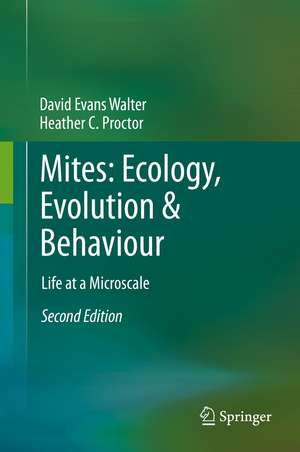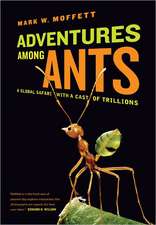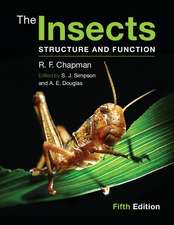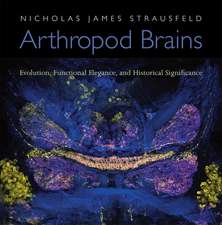Mites: Ecology, Evolution & Behaviour: Life at a Microscale
Autor David Evans Walter, Heather C. Proctoren Limba Engleză Hardback – 18 oct 2013
| Toate formatele și edițiile | Preț | Express |
|---|---|---|
| Paperback (1) | 650.86 lei 6-8 săpt. | |
| SPRINGER NETHERLANDS – 23 aug 2016 | 650.86 lei 6-8 săpt. | |
| Hardback (1) | 1214.03 lei 6-8 săpt. | |
| SPRINGER NETHERLANDS – 18 oct 2013 | 1214.03 lei 6-8 săpt. |
Preț: 1214.03 lei
Preț vechi: 1480.53 lei
-18% Nou
Puncte Express: 1821
Preț estimativ în valută:
232.34€ • 241.66$ • 191.80£
232.34€ • 241.66$ • 191.80£
Carte tipărită la comandă
Livrare economică 14-28 aprilie
Preluare comenzi: 021 569.72.76
Specificații
ISBN-13: 9789400771635
ISBN-10: 9400771630
Pagini: 350
Ilustrații: XIV, 494 p. 128 illus., 31 illus. in color.
Dimensiuni: 155 x 235 x 27 mm
Greutate: 9.73 kg
Ediția:2nd ed. 2013
Editura: SPRINGER NETHERLANDS
Colecția Springer
Locul publicării:Dordrecht, Netherlands
ISBN-10: 9400771630
Pagini: 350
Ilustrații: XIV, 494 p. 128 illus., 31 illus. in color.
Dimensiuni: 155 x 235 x 27 mm
Greutate: 9.73 kg
Ediția:2nd ed. 2013
Editura: SPRINGER NETHERLANDS
Colecția Springer
Locul publicării:Dordrecht, Netherlands
Public țintă
GraduateCuprins
Preface to the second edition.- 1. What good are mites?.- 2. The origin of mites: fossil history and relationships.- 3. Systematic and morphological survey.- 4. Life cycles, development and size.- 5. Sex and celibacy.- 6. Mites in soil & litter systems.- 7. Acari underwater, or, why did mites take the plunge?.- 8. Mites on Plants.- 9. Animals as habitats.- 10. Mites that cause and transmit disease.- 11. Mites & biological diversity.- 12. Mites as models.
Recenzii
From the book reviews:
“This is a very readable, easy-to-follow book. It starts with a brief introduction about mites and their ecological role and continues with the intricacies of mite biology. … Thanks to the well-organized, end-of chapter references, these readers can locate some of the original works on the subject. … It is also very well written and designed and provides more illustrations than its predecessor. Summing Up: Highly recommended. Upper-division undergraduates through professionals.” (J. M. Gonzalez, Choice, Vol. 51 (9), May, 2014)
“This book is the second edition of an overview of the mites (Acari), which explores their fascinating biology, with emphasis on ecology, evolution and behaviour. … this outstanding book is highly recommended for amateur and professional biologists, interested students, specializing acarologists and for libraries. … The entire book is written in a ‘friendly’, clear, non-obtuse style with scientific terms explained, and it gains much by the many illuminating Figures.” (Uri Gerson, Experimental and Applied Acarology, Vol. 64, 2014)
“This is a very readable, easy-to-follow book. It starts with a brief introduction about mites and their ecological role and continues with the intricacies of mite biology. … Thanks to the well-organized, end-of chapter references, these readers can locate some of the original works on the subject. … It is also very well written and designed and provides more illustrations than its predecessor. Summing Up: Highly recommended. Upper-division undergraduates through professionals.” (J. M. Gonzalez, Choice, Vol. 51 (9), May, 2014)
“This book is the second edition of an overview of the mites (Acari), which explores their fascinating biology, with emphasis on ecology, evolution and behaviour. … this outstanding book is highly recommended for amateur and professional biologists, interested students, specializing acarologists and for libraries. … The entire book is written in a ‘friendly’, clear, non-obtuse style with scientific terms explained, and it gains much by the many illuminating Figures.” (Uri Gerson, Experimental and Applied Acarology, Vol. 64, 2014)
Notă biografică
Dave Walter has more than 30 years experience in the study of mites in Australia, the United States, and Canada and is an author of numerous research papers, book chapters, books, interactive keys, and webpages on mite ecology, behaviour, systematics and identification. He is especially interested in the roles that mites play in biological diversity in the soil and in the canopy of rainforests and in the interactions of mites with plants and animals. Dave was formerly a Senior Lecturer at the University of Queensland and a Senior Research Scientist at Colorado State University. Currently, Dave is a scientist at the Royal Alberta Museum where he is responsible for taxonomic advice and mite identifications for the Alberta Biodiversity Monitoring Institute, Editor-in-chief of the International Journal of Acarology, and an Adjunct Professor at both the University of Alberta and the University of the Sunshine Coast in Queensland.
Heather Proctor is a native of Alberta, Canada, where she spent many hours of her childhood collecting and watching freshwater invertebrates. Her undergraduate thesis research at the University of Alberta focused on the diversity of Albertan water mites, and was followed by an M.Sc. (U. Calgary) and Ph.D. (U.Toronto) on the predatory and reproductive biology of these fascinating animals. She has held academic positions at Queen's University in Ontario, Griffith University in Queensland, and the University of Alberta where she is now a professor. Her acarological research interests have expanded to include mites associated with birds and soil as well as water.
Heather Proctor is a native of Alberta, Canada, where she spent many hours of her childhood collecting and watching freshwater invertebrates. Her undergraduate thesis research at the University of Alberta focused on the diversity of Albertan water mites, and was followed by an M.Sc. (U. Calgary) and Ph.D. (U.Toronto) on the predatory and reproductive biology of these fascinating animals. She has held academic positions at Queen's University in Ontario, Griffith University in Queensland, and the University of Alberta where she is now a professor. Her acarological research interests have expanded to include mites associated with birds and soil as well as water.
Textul de pe ultima copertă
What creatures live in the dark depths of the ocean, in the lungs of birds, in the canopies of rainforests and in the pillow beneath your head? MITES. Wherever biologists have peered, from forest floors to facial pores, they have found these tiny arachnids. More than 40,000 species have been described, and up to 1 million may grace our planet. Mites are predators, parasites, herbivores and detritivores. They are vectors of disease, vital players in soil formation and important agents of biological control. But despite the grand diversity of mites, even trained biologists are often unaware of their significance.
Mites: Ecology, Evolution and Behaviour (2nd edition) aims to fill the gaps in our understanding of these intriguing creatures. It surveys life cycles, feeding behaviour, reproductive biology and host-associations of mites without requiring prior knowledge of their morphology or taxonomy. Topics covered include evolution of mites and other arachnids, mites in soil and water, mites on plants and animals, sperm transfer and reproduction, mites and human disease, and mites as models for testing ecological and evolutionary theories.
Richly illustrated with 128 diagrams, pictures and scanning-electron micrographs, 31 of which are in colour, Mites: Ecology, Evolution and Behaviour (2nd edition) combines the authors’ more than 50 years of experience as acarologists with reviews of more than 1600 journal articles and books (450 of these new since the first edition) to reveal the bizarre ingenuity and the importance of these fascinating animals.
Mites: Ecology, Evolution and Behaviour (2nd edition) aims to fill the gaps in our understanding of these intriguing creatures. It surveys life cycles, feeding behaviour, reproductive biology and host-associations of mites without requiring prior knowledge of their morphology or taxonomy. Topics covered include evolution of mites and other arachnids, mites in soil and water, mites on plants and animals, sperm transfer and reproduction, mites and human disease, and mites as models for testing ecological and evolutionary theories.
Richly illustrated with 128 diagrams, pictures and scanning-electron micrographs, 31 of which are in colour, Mites: Ecology, Evolution and Behaviour (2nd edition) combines the authors’ more than 50 years of experience as acarologists with reviews of more than 1600 journal articles and books (450 of these new since the first edition) to reveal the bizarre ingenuity and the importance of these fascinating animals.
Caracteristici
Aimed at the general naturalist and other non-experts Ideal for students and researchers unfamiliar with mites Lavishly illustrated with drawings and electron micrographs The only introductory book on mite behaviour and ecology in English












